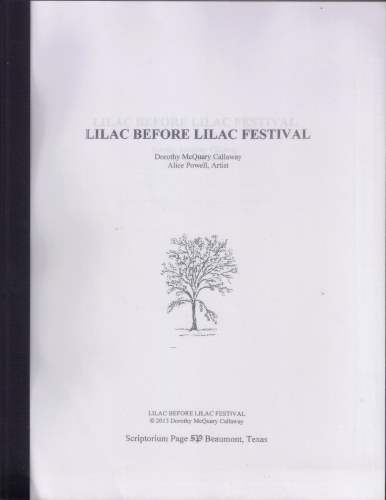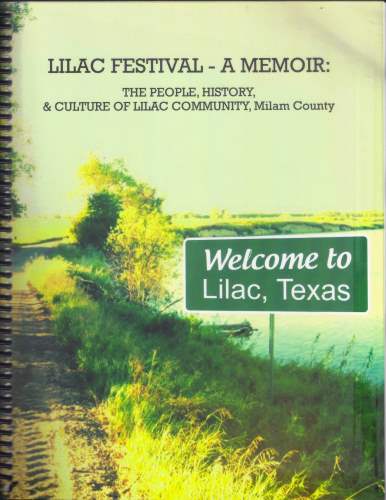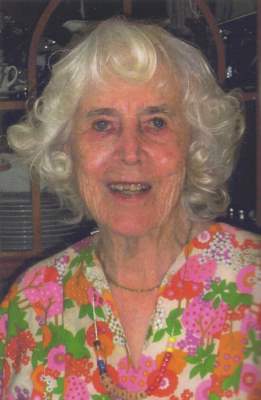




Milam County Historical Commission
Milam County, Texas
Milam County, Texas

The following introductions are written by Dorothy McQuary Callaway about two books she
has written about Lilac Community in Milam County, TX. She was raised in the Lilac
Community and these entertaining books are very interesting and informative. You will
enjoy these books even if you have never heard of Lilac Community. She has generously
donated copies of these books to local libraries.
**********
Lilac Festival – A Memoir: The People, History, and Culture of Lilac Community,
Milam County, Texas by Dorothy McQuary Callaway
Lilac festival – Memoir is a fictional account of one man’s desire to create a festival
to honor EMIL BOECKER that grew up in the Lilac Community and attended Lilac School
during the 1920s and early 1930s. RHINEHOLD BOECKER, his grandson and fourth generation
German immigrant, persuades local historian OWEN RACHEL GRAVES to guide him in the
organization of LILAC FESTIVAL that will bring together members of the Lilac community
as they re-create elements of Lilac history and culture and showcase diverse assortment
of cultural groups for a one-day celebration. In the process individuals recall stories
and experiences from their own childhood and retell them against the backdrop of work by
committees actually planning LILAC FESTIVAL, with a parade, dances, games, food, and a
typical school day. Boecker’s grand idea centers on what his grandfather once said, “All
I know I learned at Lilac School.” This becomes the motivation for Boecker to go ‘all
out’ with an assortment of festival events in search of the illusive magic that his
grandfather learned that gave him the key to success during the Depression years of the
1930s. In the process of his search Boecker learns simple truths that his grandfather
came to know in his youth while living in Lilac. Boecker discovers these truths as he
observes Sid McQuary set up an electric fence, from a local writer’s regional best seller
about plowing the turn row, for a local boy’s concern for authentic historical events,
from a school kid’s observations of a horney toad that performs and then awaits applause,
and from quilts created by Lilac ladies that capture the history, environment and beauty
of Lilac. After months of preparation and with much anticipation the Lilac community
awaits the Parade to proceed down 487 and listens for the sound of trumpets to open LILAC
FESTIVAL, 2012.
This 300 page book contains facets of the geographical Lilac community, historic accounts
of members of the McQuary family, fictional accounts of events of Lilac School from 1922-
1930, fictional events planned for Lilac Festival that incorporate actual historic
events, stories handed down through families, references to historic events that helped
to shape the community, and an overview of modern day Lilac community.
LILAC FESTIVAL: A MEMOIR, publication date – April 15 in an edition of 30 copies, 24 of
which already are designated for distribution by the author. If you would like a copy,
please fill out the form and send to me before April 15 so that I may add the number to
my printing contract. A contribution toward printing cost is greatly appreciated. Actual
cost of printing is $45, per copy.
Thank you,
Dorothy McQ Callaway
950 23rd Street
Beaumont, TX 77706
409-209-0183
email: dmcqc(AT)gt.rr(DOT)com
(NOTE: If enough people are interested in obtaining copies of this wonderful book, there
may be a 2nd printing – please contact Ms Callaway with your interest in purchasing these
books.
************************************************************************
In writing my MEMOIRS I have chosen memories to explore that may have interest for you.
As children, we live such ordinary lives we assumed that no one would care to join us on
the farm either for work or play and certainly would not want to attend Lilac School with
its limited opportunities for learning. The school provided a modest curriculum, yet we
also had opportunities to learn from our parents on the farm with freedom to explore the
great outdoors. Children participated fully in all community activities, be it church,
family gatherings, ”candidate speakings” before elections, P.T.A. programs, or funerals.
These expanded our learning opportunities and allowed us to interact with others of
various generational levels and persons with different cultural backgrounds. Many of the
children in Lilac School were the first in their families to harbor the idea of
“graduating”, even if it only was from seventh grade; yet many of us did go on to
graduate from eleventh grade and a few graduated from college. Given the years of the
1920s and through the 1930s. that truly was a remarkable achievement.
I can look back on a few things I learned at Lilac School: how to cut and fold paper and
sew sheets into books and how to stand erect by the teacher’s desk to recite my lesson.
On the playground I learned to follow rules and to take turns at the water fountain. Our
teacher gave us lessons on respect for authority, our elders, and the flag. She set up a
“store” and we learned to buy items with “cut out” paper nickels and pennies. None of us
had access to enough real money to learn how to count and make change. Yes, we also
learned a lot of things that no longer have relevance to living, but I hope you will see
how these everyday activities contributed to our education as we looked toward the
future. As the 1930s drew to a close the boys of Lilac became part of the “Greatest
Generation,” and they knew why they were fighting on the battlegrounds and oceans of the
world. They had spent their early years trying to create a better life, to become
someone that commanded respect. The girls looked forward to marriage and families, but
most of them also wanted a career beyond home and farm work. The meager education we
received at Lilac gave us a vision of what we might accomplish beyond our school days.
In MEMOIRS you shall encounter a few individuals that are truly exceptional as judged by
what they have been able to do with their education and perseverance. With all the new
technologies that govern our lives you, too, will have memories that are alien to us
older folk, but they will be just as interesting to your grandchildren as playing in the
“cottonseed pen” was to my children. I regret that my children did not learn how to make
molasses as I did, for that is an event with many interesting facets. In 1943. instead
of writing a bio as required to prove to Texas Women’s University that I could, indeed,
read and write the English language I wrote an essay on “How to Make Molasses”. I
underscored the idea that I learned to be patient while walking behind a mule that was
going in circles turning the mill to press juice from cane as Brother Sid fed it between
the rollers. Did the mule need someone to tap him across the rear end? No, but my daddy
wanted me out of the way when he slung hot skimmings off the home-made skimmer into a
bucket, later to be given to the hogs. Boiling cane juice produces foam that must be
skimmed off. Barefooted kids have to learn a lot of things, and Daddy didn’t have time
to teach me before I would have burned my feet, so he put me behind the mule. Not only
did I learn patience, but also I parlayed that trail via an essay into a B.S. Degree with
honors to boot!
LILAC BEFORE LILAC FESTIVAL contains McQuary tales and stories about Lilac School.
LILAC FESTIVAL – A MEMOIR covers the organization of Lilac Festival, a celebration of the
people, history, and culture of Lilac Community.
Dorothy McQ Callaway
950 23rd Street
Beaumont, TX 77706
409-209-0183
email: dmcqc(AT)gt.rr(DOT)com
See also Joy Graham's articles about these books:



Dorpthy McQuary Callaway in writing about Lilac School and Lilac community takes a romantic view of the simple farm life and makes of it a most unique experience. Born on McQuary Farm in 1922. She began her educational experience at Lilac School on April 12, 1929, the day after her seventh birthday and completed first grade the first week in May when school closed for summer vacation. Although she continued to live in lilac community she entered Friendshp School in the fall of 1930 and graduated from Sharp High School in 1939/ At age seventeen she left McQuary Farm to attend college. She became a career teacher with service in high schools and coleges in Texas and Arkansas, ending her formal teaching career in Taiwan, R.O.C. She continued to reach out to children and young adults as a volunteer with the American Red Cross, Beaumont Art league, Gladys City Historical Museum, Houston Callgraphy Guild andother educations entities, museums, and Trinity Methodist Church by teaching classses and workshops in safety education, art, calligaphy,and book arts. She began to write small monographs about pre=technology farm life as well as family stories, many handed down from aged relatives. These stories ispired her to recall and record stories unique to Lilac School and Lilac Community.
(Biography from back cover of Lilac Festival - A Memoir)
(Biography from back cover of Lilac Festival - A Memoir)
.